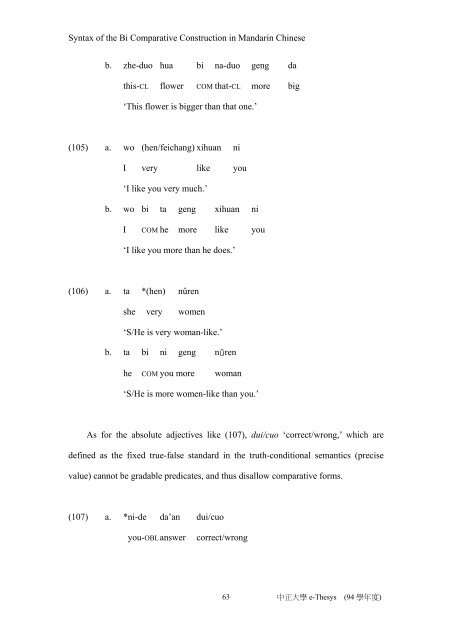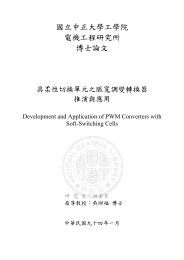Syntax of the Bi Comparative Construction in Mandarin Chinese
Syntax of the Bi Comparative Construction in Mandarin Chinese
Syntax of the Bi Comparative Construction in Mandarin Chinese
You also want an ePaper? Increase the reach of your titles
YUMPU automatically turns print PDFs into web optimized ePapers that Google loves.
<strong>Syntax</strong> <strong>of</strong> <strong>the</strong> <strong>Bi</strong> <strong>Comparative</strong> <strong>Construction</strong> <strong>in</strong> Mandar<strong>in</strong> Ch<strong>in</strong>ese<br />
b. zhe-duo hua bi na-duo geng da<br />
this-CL flower COM that-CL more big<br />
‘This flower is bigger than that one.’<br />
(105) a. wo (hen/feichang) xihuan ni<br />
I very like you<br />
‘I like you very much.’<br />
b. wo bi ta geng xihuan ni<br />
I COM he more like you<br />
‘I like you more than he does.’<br />
(106) a. ta *(hen) nűren<br />
she very women<br />
‘S/He is very woman-like.’<br />
b. ta bi ni geng nűren<br />
he COM you more woman<br />
‘S/He is more women-like than you.’<br />
As for <strong>the</strong> absolute adjectives like (107), dui/cuo ‘correct/wrong,’ which are<br />
def<strong>in</strong>ed as <strong>the</strong> fixed true-false standard <strong>in</strong> <strong>the</strong> truth-conditional semantics (precise<br />
value) cannot be gradable predicates, and thus disallow comparative forms.<br />
(107) a. *ni-de da’an dui/cuo<br />
you-OBL answer correct/wrong<br />
63<br />
中正大學 e-Thesys (94 學年度)





